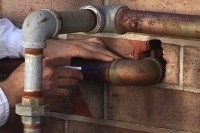As food processors and retailers work tirelessly to feed the public during the current global health pandemic, pests continue to work overtime to keep their food supply on track. Filth flies, cockroaches and rodents, in particular, pose a threat to the food supply chain, especially with concerns of the transmission of pathogens at an all-time high. The last thing your business needs is an avoidable food safety incident that threatens your reputation and bottom line.
When it comes to food safety, pathogen-spreading pests have no place in your facility and pose a major public health risk. Not only can these filthy pests become a nuisance within your facility, they can also contaminate your products and spread foodborne bacteria such as Salmonella, E. coli and Listeria, which can cause illnesses.
Knowing what attracts these pests to your facility and the dangers they pose is important for effective removal. Let’s dive into the signs of cockroaches, filth flies and rodents, and the specific concerns they can cause.
Frank Meek will share his expertise during a complimentary webinar on March 4, “Making the Grade: Tips for Passing Food Safety Audits During the Pandemic” Cockroaches
Cockroaches seek four things that food processing facilities provide in abundance—food, shelter, proper temperatures and water. With the ability to squeeze through tiny gaps and cracks, these dirty pests enjoy crawling under equipment, in cabinets and through drains to find their next meal. Cockroaches can be found in and around almost any place within your facility. They’re capable of carrying harmful bacteria that they can spread from one location to another. Look out for droppings, cast skins or egg cases, which might signal a cockroach problem.
Filth Flies
You may think these types of flies have no desire to be inside, but they are in fact happy to go wherever the conditions are right. The most common filth fly is the housefly. These winged pests can carry and spread more than 100 disease-causing pathogens including bacteria, fungi and viruses. These can cause illnesses such as cholera, dysentery and infantile diarrhea. Filth flies in your facility can lead to a major public health issue if your food becomes contaminated.
Rodents
One of the filthiest pests around, rodents can contaminate your food supply, destroy or consume products and cause structural damage to your facility. Like cockroaches, mice and rats can fit through relatively small spaces to find food and water. With sightings on the rise during the COVID-19 pandemic, you’ll want to keep an eye out for rodents near your food products. These mighty chewers pose a public health threat as they can transmit diseases such as hantavirus and lymphocytic choriomeningitis (LCM) via their urine and droppings.
The presence of these vermin in your facility threatens public health. Additionally, an infestation can slow down the supply chain by causing businesses to recall contaminated foods.
A rigorous sanitation routine is one of the most effective ways to proactively manage pests like cockroaches, rodents and filth flies. Regularly sanitizing and disinfecting your facility can help eliminate any pathogens left behind on hard surfaces and remove the attractants for which they search. While cleaning removes dirt and buildup, sanitization and disinfection kill bacteria and pathogens, reducing the risk of a food safety issue.
Including the following tips in your cleaning routine can help keep your products and reputation safe from harm.
- Clean out drains routinely with an enzymatic cleaning solution that can break down the organic grime.
- Disinfect high-touch hard surfaces with a proper and low-toxicity disinfectant to kill bacteria and pathogens that can cause food illnesses.
- Move dumpsters away from your building to reduce flies being attracted to and then gaining easy entry into your facility.
- Wipe spills as soon as they occur to prevent them from becoming a sticky paradise for flies and cockroaches.
- Practice good hygiene in your work environment and ensure employees are washing their hands regularly and keeping break rooms free of trash and leftovers.
Implementing exclusion practices such as sealing cracks, gaps and holes in walls with a proper sealant can also help you keep pests out. Budget allowing, consider investing in insect light traps and mechanical traps to help reduce flying insects inside.
Communication with your suppliers and distributors is also important to ensure food safety. If your partners implement similar measures, you’re more likely to protect the public from harmful diseases. Furthermore, customers will continue to trust your business.
While following these tips can help reduce the chances of a pest infestation, it’s not always possible to keep pests and the pathogens they spread out of your food processing facility. Work with a trained pest control specialist to develop a customized prevention program for your business as each type of pest requires specific treatment. They can also help you schedule inspections to identify conditions in and around your facility that may attract flies, cockroaches and rodents, among other pests.








